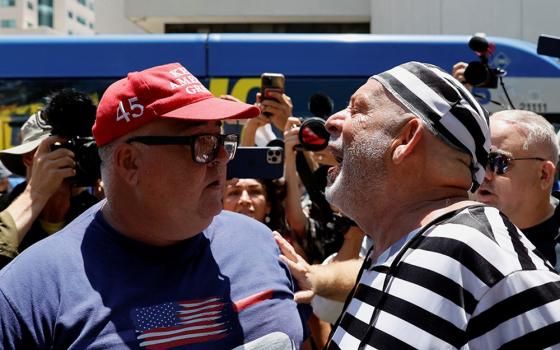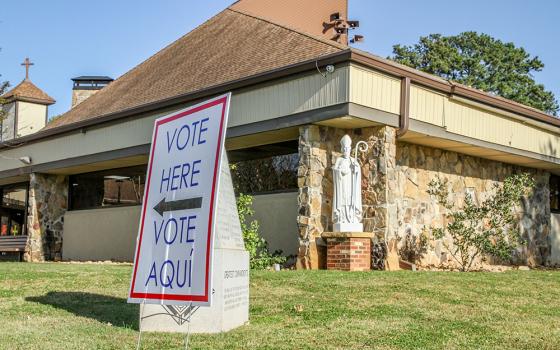The creation of a new Vatican Congregation for the Laity appears to be a likely first step in the reform of the Roman Curia. Many are welcoming this as a recognition that the laity have just as important a role in the church as bishops, clergy and religious, each of which has a congregation dedicated to their concerns.
Reform of the Curia has been a major item of the agenda of Pope Francis' Council of Cardinals.
Currently, there is a Council for the Laity, but in the Vatican pecking order, councils are ranked below congregations. For example, a cardinal must head the nine Vatican congregations, but the 12 councils can make do with an archbishop. Not only would the laity council be upgraded, it would be merged into a larger entity that could take over the functions of the Council for the Family, the Council for Health Care Workers, and the Council for Pastoral Care of Migrants and Itinerant People.
Whether this new entity will be a congregation or a secretariat, like the new secretariat dealing with Vatican finances, remains to be seen. In any case, a cardinal will head it, and Honduran Cardinal Oscar Rodriguez Maradiaga's name has been floated. Laypeople could head offices within the congregation.
Another entity may result from the merger of the Council for Justice and Peace and the Council Cor Unum. One plan would put the portfolios of the Council for Health Care Workers and the Council for Pastoral Care of Migrants and Itinerant People into this new congregation rather than into the Congregation for the Laity. If these councils go to the laity congregation, the emphasis would be on pastoral care for migrants and health care workers. If they go to a new Congregation for Justice and Charity, then the emphasis would be on charity and justice.
A possible solution is to put the pastoral work of these offices into the laity congregation while the charity and justice work would go to the new justice and charity congregation. This is not easy, of course, since people in the old offices often have multiple responsibilities.
Still another new congregation or secretariat may combine all of the communications offices: the Vatican press office, L'Osservatore Romano, Vatican Publishing House, Vatican Radio, Vatican Television Center, Vatican Information Service, news.va, and the Council for Social Communications.
These proposals respond to cardinals and bishops outside of Rome who see the Curia as a bloated bureaucracy that wastes money. They want an efficient operation with fewer officials spending less money. In this, they sound like Republicans talking about Washington.
In reality, the Vatican bureaucracy is very small, considering the church is a 1.2 billion member organization. I often point out that American universities have more press officers for their sports teams than the Vatican has for its entire operation.
What will be the impact of these mergers?
First, merging a number of councils into fewer entities will reduce the number of Vatican offices that could be headed by a cardinal. While councils do not have to be headed by a cardinal, often they have been. If one of the goals of reform is to reduce the number of cardinals in the Curia, then this is a positive change.
Second, the mergers will mean that fewer Vatican officials will have direct access to the pope. Just as there cannot be hundreds of government officials reporting directly to the president, the pope cannot personally deal with scores of department heads. These mergers mean that some Vatican office heads who in the past reported to the pope will now report to someone else.
In reality, since the papacy of Pope John Paul II, popes have been selective in whom they meet. Pope Paul VI would meet almost monthly with heads of major Vatican offices. He would also carefully review any documents prior to their being issued by a Vatican office. Because of his travels and other activities, John Paul had neither the interest nor the time to do this. Some department heads could go a year or more without seeing him, and he left the review of documents to Cardinal Joseph Ratzinger, who made sure the Vatican spoke with one voice.
With as few as 12 major curial offices, the pope could also bring the heads of office together like a Cabinet for coordination and counsel. While Cabinets work well in parliamentary systems, U.S. presidents have never found Cabinet meetings helpful except for photo ops.
A third argument for merging similar offices is to encourage coordination and efficiency. This was one of the arguments supporting the creation of the U.S. Department of Homeland Security and many of the more recent Cabinet-level departments in the United States.
Combining offices can lead to the pooling of resources and the elimination of duplication. For example, people who organize World Youth Day could also organize the World Meeting of Families. But mergers can also mean that some priorities will be lost in the bureaucracy. A small office, for better or worse, has more freedom to do what it wants. When it is part of a larger entity, it has to get approval from supervisors. There are fewer loose cannons, but also less creativity.
Bringing all the Vatican media offices together makes good sense to get everyone on the same page and to take advantage of new communication technology. To be successful, such a merger will require a very strong executive to overcome entrenched ways of operating. Changes in technology and priorities mean that staff members have to be continually retrained. But the Vatican's reluctance to fire people will make it difficult to get rid of dead wood and redundancies.
Sometimes Cabinet-level departments combine offices that do not fit well together or have little in common. For example, in the United States, the Census Bureau and the National Oceanic and Atmospheric Association, which have little in common, are both in the Department of Commerce.
Likewise, although a Congregation for Charity and Justice sounds good, it is difficult to see how the Councils for Justice and Peace and Cor Unum will fit easily together. The first is more like a think tank while the second distributes the money from Peter's Pence. If the new congregation combines the portfolios of Justice and Peace, Cor Unum, Health Care Workers, and Migrants and Itinerant People, it will have to pick and choose what it really wants to do.
Most Vatican offices have a mix of jurisdiction and promotional functions. Jurisdictional authority is the authority to make a decision on a particular matter that is binding on people, even bishops, under canon law. The laity office will have little jurisdictional authority except for the review and approval of the charters of international Catholic lay organizations, which was a responsibility of the Council for the Laity.
Most of the work of the new laity office will be promotional. It will operate more through education and persuasion than mandates. The office will put on conferences; its staff will travel to conferences held by others to make presentations. It will publish documents, newsletters, and other publications giving the results of their work and promoting study and action by others in the church.
All of these activities are dependent on its ability to persuade people. For example, it can call for greater involvement of the laity in the church, but if local bishops and priests ignore it, nothing will happen.
In its promotional activities, the laity office will be similar to a public policy think tank except that it will deal with issues from a religious or ethical perspective. Its success will depend on its credibility, the quality of its work, and its ability to attract and persuade a particular audience. Like the new communications office, it will need a good leader who is in tune with the pope.
One of its audiences should be other members of the Roman Curia. Will it speak out for the laity in decisions in other Vatican offices, for example, in the selection of bishops, the training of seminarians, or in the reform of the liturgy? If it does not, the laity will not be well served.
The merging of these offices will be seen in Rome as a major achievement, but in reality, it is a minor reform. It is shuffling around boxes on the organizational chart. It is noteworthy that these reforms focus on the councils created after the Second Vatican Council and do not touch the older Vatican congregations.
Real structural reform, as I have written elsewhere, requires:
- Not making Vatican officials bishops or cardinals.
- Returning decision-making authority on more issues to bishops' conferences and local bishops.
- Clearly separating legislative, executive, and judicial functions.
But besides changing structures and procedures, there has to be a cultural change in the Curia. Pope Francis has been preaching and modeling such a change since the beginning of his papacy. He speaks of leadership for service rather than for power and status. He clearly hates careerism and clericalism.
Reforming the Curia is not easy, nor is it impossible. There are no perfect solutions, but major improvements can be made.
[Jesuit Fr. Thomas Reese is a senior analyst for NCR and author of Inside the Vatican: The Politics and Organization of the Catholic Church. His email address is treesesj@ncronline.org. Follow him on Twitter: @ThomasReeseSJ.]
Editor's note: We can send you an email alert every time Thomas Reese's column, Faith and Justice, is posted. Go to this page and follow directions: Email alert sign-up.



